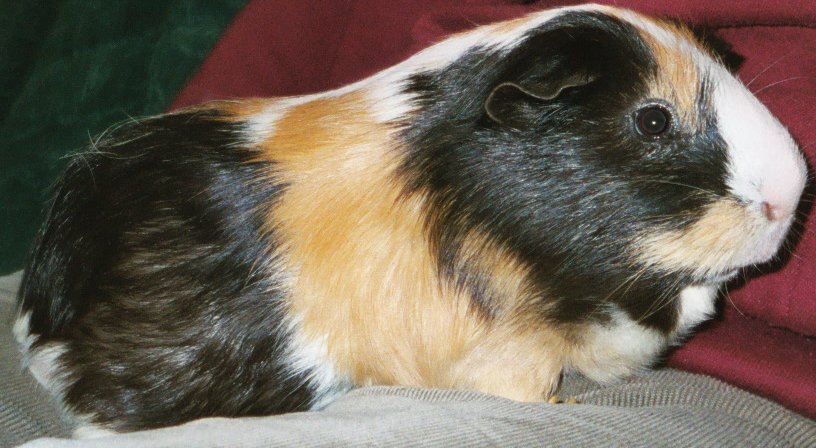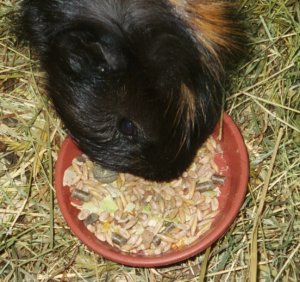|

In order
to stay healthy, have soft, gleaming fur, and sparkling
eyes, a guinea pig needs to maintain
a healthy diet. The most important food for a guinea
pig is fresh plants.
Remember,
every guinea pig is an individual, so if one doesn't
like apples much, for instance, there's probably nothing
wrong with the guinea pig or the apples.
Grass
One of
the most healthy plants for a guinea pig is normal
grass. But if you want to feed them some grass,
don't just pick it anywhere. Try not to pick it
where dogs are often walked - the guinea pigs might
catch a disease, or parasites. Certainly do not
feed the guinea pigs plants which are growing near
roads, as the dirty air and benzene liquid
which the cars expose causes the local plants to
mutate and become highly poisonous. It is best if you find
a spot where a lot of clean, rarely mowed grass
grows, and pick grass from that place.
Wild
Plants
These
plants are often fed to guinea pigs:
Burdock
Plantain
Dandelion
- Guinea pigs love to eat dandelions, they especially
like the sap, but some types of dandelions are also
harmful in some ways, so don't feed too much of
it. The percentage of dandelions in your guinea
pig's green diet should be about 30%.
The common dandelion
which is safe to eat in unlimited portions has leaves growing almost
straight from the roots, and separate bare stems with single flowers
at the top.
Milfoil
Nettle
-
The nettle's leaves are incredibly rich with vitamins.
Nettle should be collected and fed while it's blooming
(from May to September), it can be tied up in a
bunch and allowed to hang until it's dried, in an
airy place, but certainly out of direct sunlight.
Its stem and flowers should be removed, and the
leaves can be threshed into flour before being fed.
Red Clover
-
It's very beneficial for a guinea pig to eat it.
Red clover can be fed altogether, with the flowers.
These
are some plants that are very poisonous and must
NOT be fed to guinea pigs.
Black
Henbane
Common Jimson
Weed
Greater
Celandine
Delphinium
Poppy
Digitalis
Lily
of the Valley
Spurge-Flax
Night-Blindness
Swamp Wild
Rosemary
Fern
Potatoes
- books usually say that potatoes are alright to
eat, but practice shows that you can't always trust
books.
Fruits
and Vegetables Suitable for Guinea Pig Feeding
Apples
- should be included in every meal.
Grapes
Lettuce
Salad
- Salad is exclusively famous for containing almost
all vitamins that are known to be in plants.
Cabbage (but
not cauliflower, eating cauliflower causes
diarrhea and can kill a guinea pig in a single
day.)
Parsley
- very rich with vitamins A and C.
Carrot
- carrot can be fed with both the root and the leaves
- especially the leaves. The carrot
supplies animals and humans with almost all required vitamins.
Cucumber
- an acknowledged delicacy among the guinea
pigs. Watery, juicy, delicious, and
loud smelling cucumber is the perfect way to fulfil
a guinea pig's thirst and win his trust. However,
99% of the cucumber is water, so it is not much
of a vitaminiser.
Other
Foods
Milk
MUST NOT be given
to guinea pigs!!!
Hay -
the hay dust should be removed before feeding. It
should not be wet, as it loses its dry flavour.
It should not contain harmful or poisonous plants.
Oats
- the most beneficial grain food.
Wheat
- only the grains, of course!
Corn
- the dried grains.
Sunflower
Seeds
Barley
The
grain food can be bought at pet-shops, usually
a mixture of the most important grain foods. 
Bread
- white bread supplies the guinea pigs with vitamins,
but it is best to dry it before feeding, as guinea
pigs have trouble digesting fresh bread.
Clean
Drinking Water - the most important component in
a mammal's diet - guinea pigs must always have enough
fresh, clean, water. It should be placed in a heavy
ceramic water bowl, so that the pet doesn't turn
it over, but better still, if it's contained in
a special water bottle attached to the outside of
the cage, with a straw running into the cage, the
end slightly blocked by a metal ball, so that the
guinea pigs can get water if they nose the movable
object.
|

